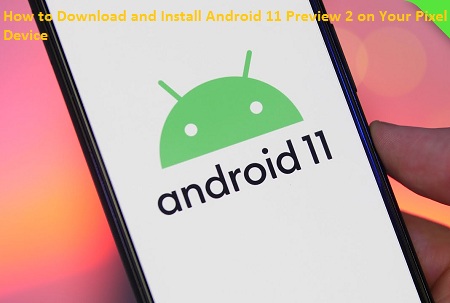How to Download and Install Android 11 Preview 2 on Your Pixel Device
Preview 2 of Android 11 has finally arrived and can be downloaded on your Pixel device. One month back for Android 11 Preview 1 was released, and now preview 2 is the latest version in Android. Preview versions release for developers for checking the apps and performance, and the company also states that it is only available for developers to install. Every Android user wants to see what’s new coming in their Android device, and for that, installing the new update is required.
The preview version had minor bugs and missing features, that’s why you should only install it if you are a developer and see what company has changed in the new version.
Currently, only Pixel devices can install preview 2 versions, and here is the list of devices that support it.
Devices that Support Preview 2 Version
- Pixel 4 XL
- Pixel 4
- Pixel 3 XL
- Pixel 3
- Pixel 3a
- Pixel 3a XL
- Pixel 2
- Pixel 2 XL
Install Latest Developer Android Preview 2 Version
To install Android preview 2, you require to flash the factory image. Before installing it on the device, take the backup of your device, so if something goes wrong, your data will be safe. Apart from this, you should have proper knowledge of the Android Software development kit (SDK) and Terminal (Linux and OS X) to tackle the situation if something goes wrong while processing with your device.
The commands will be written in Terminal on Linux or the OS X platform. From this procedure, you will require a Windows machine, and then you will no longer require to use “./” in the guide. All you need to enter the command in line with the way they are listed.
Enable USB Debugging and Developer Settings
- Launch “Settings” and slide down to the “About device” feature.
- Click on the “Build number” multiple times until the dialog box says you are a developer.
- Get back to the “Settings” menubar.
- Find and click on “Developer options.”
- Keep the developers option “turned on” and “USB debugging” on too.
- Connect your device with a computer through a cable
- Press on “OK” on dialog box when asked “Allow USB debugging” during connected to PC.
- You can choose to always allow access to that computer on the device.
Unlock The Bootloader
A bootloader is available in Pixel devices to unlock that brought through Google. For doing it, you need to boot your device through the bootloader. To do it manually, Turn off your Pixel device and press the power button along with the volume down button. After this, you will enter the bootloader menu. Now follow the given commands to ensuring your device is ready for updating.
- ./adb devices
Enter the bootloader menu by the following command.
- ./adb reboot bootloader
Bottom of your device’s screen there, you will see various lists with the lock state of the device. Unlock the bootloader because it will be required at the time of flashing stock firmware image, and just keep following the commands. At the time of unlocking the bootloader of the device, it will “factory reset” your device. Keep a backup of your device because your data will be lost while doing it. Now get back to unlocking bootloader.
Type:
- ./fastboot flashing unlock
After doing it, a statement will appear on the device that if you are ready about unlocking. It will factory reset the device again, but you can back out from it by choosing “no” from the power button. However, if your device is ready along with you, then just tap the “volume up” with pressing the power button to ensure unlock the bootloader.
- ./fastboot reboot-bootloader
Flashing the Factory Image
The bootloader of your device is unlocked, and now you need to flash your device for new firmware. Find the image head in your device and download it. Uncompress the file you downloaded, so at the time of flashing, you will have the file to choose. While your device is in the bootloader section, make sure your PC is properly connected to the mobile device. Until you don’t see your device’s serial number is connected, you can update your device.
- ./fastboot devices
After confirming it with your phone and computer is ready to communicate, just get to the flashing part.
- Navigate to the location of the “factory image file” that you extracted after downloading.
- Use command Flash-all to begin flashing the firmware.
- If using Mac, use flash-all.sh.
- If using Windows, use flash-all.bat.
With this procedure, your mobile device will start to restart itself and boot normally. After it completes, your data will be clear from your device. The process could take some extra time if you are doing it for the first time. Once it is complete, your device will set up as new firmware.
Nelson King is a creative person who has been writing blogs and articles about cyber security. He writes about the latest updates regarding mcafee.com/activate and how it can improve the work experience of users. His articles have been published in many popular e-magazines, blogs and websites.

Comments
Post a Comment